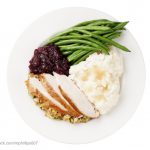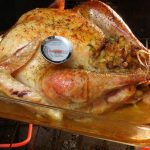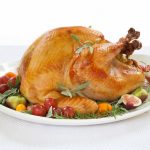Foodsafety.gov is offering tips on how to cook Thanksgiving turkey. This bird is the centerpiece of most holiday dinners in America today. Cooking it thoroughly to a safe final internal temperature is crucial to keep you and your family safe. Turkeys, like chickens, can have Salmonella and Campylobacter bacteria on their skin. They must be carefully handled and completely cooked to prevent foodborne illness. First, never rinse the turkey. That step aerosolizes bacteria on the bird and spreads it around your kitchen. Just pat the turkey dry. The easiest way is to put a completely thawed unstuffed turkey into a roasting pan, set the oven to 325°F, and let it cook. Test it with a food thermometer after 3 hours, which is how long an 8 to 12 pound bird should cook. The larger the … [Read more...]
Thanksgiving Meal Food Safety Tips From the Experts
The Thanksgiving meal is the largest one most people prepare and serve every year. To make sure that your Thanksgiving dinner is wholesome and safe, Foodsafety.gov is offering tips. The turkey is the centerpiece of the meal, and it should be handled and cooked properly to make sure it is safe to eat. First, read labels carefully when you buy the bird. The label will tell you whether the bird is fresh or frozen. If you want to serve a fresh turkey at your Thanksgiving meal, buy it no more than two days before the meal. You should have two thermometers in your kitchen; one in the fridge to make sure that the turkey is stored at 40°F or below, and another to make sure the cooked turkey reaches 165°F, the safe final internal temperatures. Remember that the color of the meat is not a … [Read more...]
Do You Want to Fry Your Thanksgiving Turkey? Read This First
Thanksgiving is right around the corner. There are many ways to prepare a Thanksgiving turkey for your feast, but some are safer than others. Many people may want to deep fry their Thanksgiving turkey. That cooking method makes a delicious turkey that has crisp skin and is juicy and flavorful. But the method can be dangerous. First, some general food safety rules for turkeys. Don't buy the bird too early. A fresh turkey should be cooked within 1 to 2 days. A frozen turkey will take about 3 days to thaw in the fridge (NEVER thaw on the counter) and then must be cooked within 2 days. You can thaw a frozen turkey by submerging the frozen, bagged bird in cold tap water, changing the water eery 30 minutes. A 12 pound turkey will take about 6 hours to thaw using this method. The turkey … [Read more...]
How to Cook a Thanksgiving Turkey
The USDA is offering consumers tips on the best ways to cook a Thanksgiving turkey. Many home cooks have never cooked such a large bird, and beginning cooks may need help to cook a turkey so it is safe as well as tender and juicy. You can see a chart for approximate turkey roasting times at the Foodsafety.gov web site. It gives you times for roasting a turkey breast, a stuffed turkey, and an unstuffed turkey, as well as turkey parts. The easiest way to cook a turkey is just to put it in a roasting pan, set the oven to 325°F, and let it cook. A 16 pound unstuffed turkey should take about 4 hours to get to 165°F using this method. To stuff a turkey, never ever stuff it ahead of time. Put the stuffing in the two cavities of the bird just before it goes into the oven. The cooking … [Read more...]
Forgot to Thaw the Turkey? Here are Three Solutions
The USDA has some tips about how to thaw your turkey quickly for Thanksgiving dinner. It should be thawed in the refrigerator; but this can take days. In fact, a 16 pound turkey takes four days to thaw. If your turkey is still frozen, it's too late to use this method. The two methods for thawing a turkey quickly are the cold water method an the microwave method. If you use these methods, you have to cook the turkey immediately after it thaws. For the cold water method, leave the turkey in its original wrapping and submerge it in a sink or container full of cold water. Change the water eery 30 minutes by emptying out the sink or container and replacing it with fresh cold water. This takes some commitment: to thaw a 16 pound turkey will take 8 hours to thaw, allowing 30 minutes of … [Read more...]
Planning to Wash Your Thanksgiving Turkey? Read This First
The USDA is offering tips on washing turkeys this holiday season. You shouldn't rinse the turkey before you cook it; but what if you plan to brine the bird? There has been a controversy about washing poultry before cooking for some time. Food safety experts do not recommend washing raw meat and poultry in your kitchen sink, simply because bacteria are loosely attached to the skin and flesh. When water hits the meat, bacteria can aerosolize and float around the kitchen. Water can splash the pathogenic bacteria up to 3 feet away from the sink. That area includes your face and hands, countertops, other towels, and the rest of the sink. Researchers at Drexel University have shown that it's best to transfer meat and poultry straight from the package to the pan. The heat used in … [Read more...]
Debunking Thanksgiving Myths
The USDA is trying to debunk Thanksgiving myths to help consumers keep their families safe over the holiday season. Many people believe these methods for preparing and storing food and they can make someone sick, perhaps seriously ill. The first myth is that it's okay to leave food outside when the weather is freezing. This may seem safe, especially if the temperature is below freezing and snow is on the ground, but it is not, for two reasons. The first reason is animal contamination. Animals can get into food stored outside, and can easily contaminate it. Wild animals often carry pathogenic bacteria such as E. coli. And family pets can also harbor bacteria, even if they do not seem sick. The second reason it is unsafe to store food outside is temperature variation. A plastic … [Read more...]
Countdown to Thanksgiving
The USDA is offering advice on the countdown to Thanksgiving Day. The key to a safe holiday is to plan ahead and make sure you follow all food safety rules. If you purchased a frozen turkey, it should be thawing in the fridge. For most sizes of frozen bird, it's too late to thaw now in the fridge. You can thaw the bird in cold water, but that takes hours, and the water should be changed every 30 minutes to make sure it stays cold. Do not thaw a large turkey in the microwave; if you do thaw a smaller turkey there, it must be cooked immediately. You can cook your turkey from the frozen state safely and easily. A fresh turkey should only be purchased one to two days before cooking. Today is a great day to buy your bird. And remember never buy a pre stuffed fresh turkey, since it is a … [Read more...]
USDA: Countdown to Thanksgiving
The USDA is offering food safety and meal planning tips for the upcoming Thanksgiving holiday in the United States. That holiday is a week away, and now is the time to start planning. First, plan early and shop early to make sure that nothing is forgotten. Shelf stable items and foods that can be safely stored for a week should be purchased now. Clean the fridge and use up foods that take space in that appliance. Make sure that you have the right equipment for the meal. The roasting pan has to be large enough for the turkey. You should have a food thermometer to make sure that all food is cooked to a safe temperature. Turkey should be cooke dot a minimum internal temperature of 165°F, checked in the innermost part of the thigh, the innermost part of the wing, and the thickest part of … [Read more...]
Safe Turkey Handling Tips for a Happy Thanksgiving
The folks at Holiday Food Safety are offering tips for handling your turkey safely for a happy Thanksgiving. The Partnership for Food Safety Education includes the Academy of Nutrition and Dietetics, the Institute of Food Technology, and other organizations. Before you buy the turkey, make sure you have room for it in your fridge. Always store the turkey in a large pan so raw juices don't drip and contaminate other foods. If you buy a frozen turkey, make sure you leave enough time for it to thaw. It takes about 24 hours for every four to five pounds to thaw in the fridge, so by now it's too late. But you can cook your turkey from the frozen state! Always wash your hands with warm water and soap for 20 seconds before and after handling the raw turkey. Never ever defrost the turkey on … [Read more...]









